Forget boring grass! Imagine a yard covered in soft, green leaves. Tiny purple, pink, or white flowers bloom thickly. Walking infuses the air with an attractive, herbaceous fragrance. Bees buzz happily. This dream is real. It’s called creeping thyme. This little plant is a superstar. It makes amazing ground cover. Perfect for replacing grass or filling tricky spots. It’s tough. It’s pretty. It smells wonderful. Let’s learn all about creeping thyme magic and how it can help you transform your outdoor space!
What exactly is Creeping Thyme?
Creeping thyme is not one plant. It’s a group of low-growing thyme plants. There are several creeping thyme varieties, each with unique growth habits and appearances, making them suitable for different landscaping needs. They belong to the mint family. These plants are super close to the ground. Usually only 2 to 3 inches tall. They spread sideways. Stems creep along the soil. They send down roots as they go. This forms a dense, mat-like cover. Think of it like a living carpet. For a comprehensive plant care guide and detailed profile of creeping thyme, you can consult reputable botanical resources like the Missouri Botanical Garden.
The leaves are very small. Often dark green. Sometimes fuzzy. In summer, magic happens. The plant explodes with tiny flowers. These flowers pack a punch. They cover the plant thickly. White, lavender, green, & purple are great hues. Bees and butterflies love them. The best part? Crush a leaf. Smell that lovely thyme scent!
Creeping thyme is perennial. That way, it comes the following year. It loves sunlight. It hates soaking feet. Ideal for warm, dry spots where the lawn struggles. Unlike creeping thyme varieties, which are low-growing and ideal for ground cover, Thymus vulgaris is the classic upright culinary herb.
Meet the Stars: Popular Creeping Thyme Types
Not all creeping thyme plants are the same. Some types are extra special:
Red Creeping Thyme (Thymus praecox ‘Coccineus’)
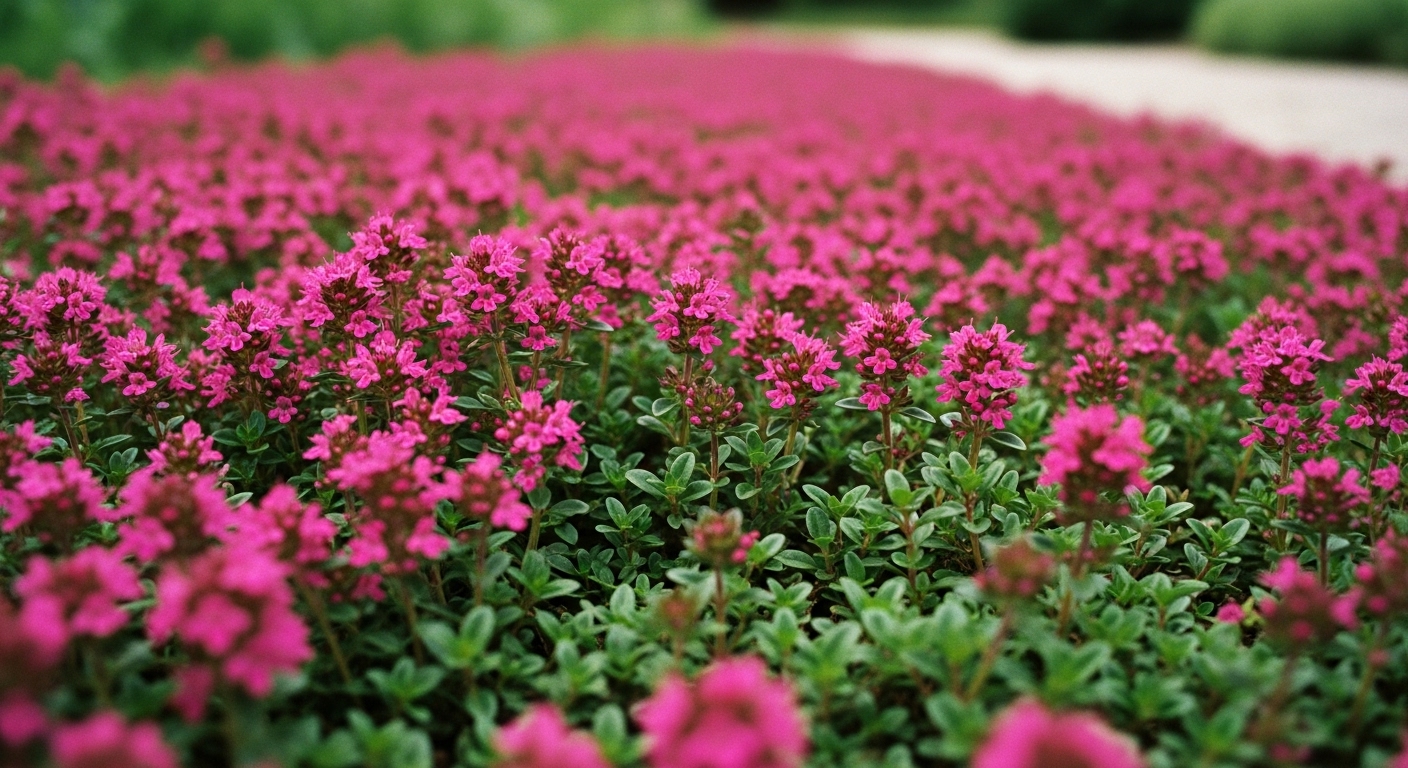 This one is famous. It’s a champion ground cover. The flowers are not truly red. More like a deep magenta or crimson-purple. Blooms are very showy. The foliage is dark green. Red creeping thyme spreads fast. It forms a tight, weed-blocking mat. Super tough for lawns or paths.
This one is famous. It’s a champion ground cover. The flowers are not truly red. More like a deep magenta or crimson-purple. Blooms are very showy. The foliage is dark green. Red creeping thyme spreads fast. It forms a tight, weed-blocking mat. Super tough for lawns or paths.
Elfin Thyme (Thymus serpyllum ‘Elfin’)
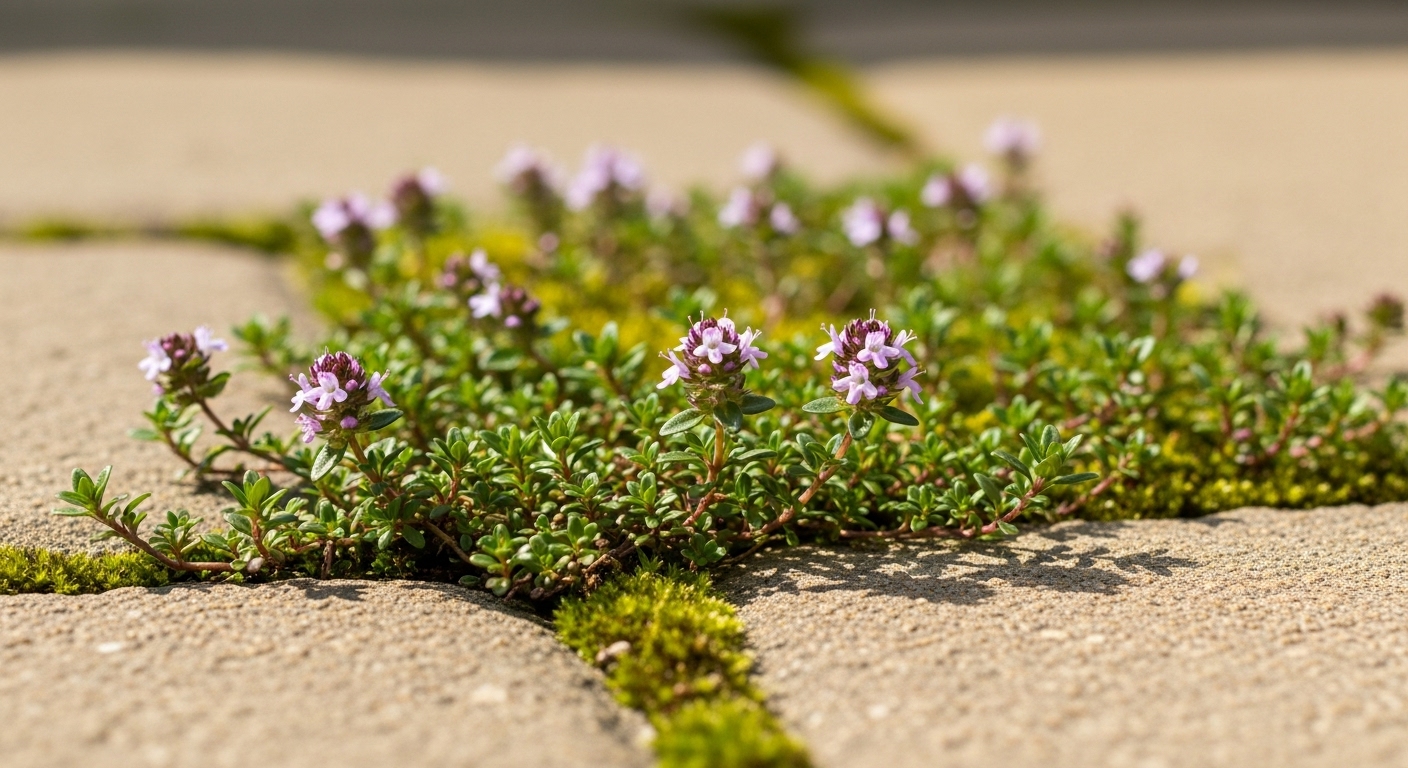 This is tiny! Grows only about 1 inch tall. Super slow spreader. Forms a super dense, moss-like cushion. Perfect for fairy gardens. Great between stepping stones. Flowers are pale lavender. Very cute.
This is tiny! Grows only about 1 inch tall. Super slow spreader. Forms a super dense, moss-like cushion. Perfect for fairy gardens. Great between stepping stones. Flowers are pale lavender. Very cute.
Woolly Thyme (Thymus pseudolanuginosus)
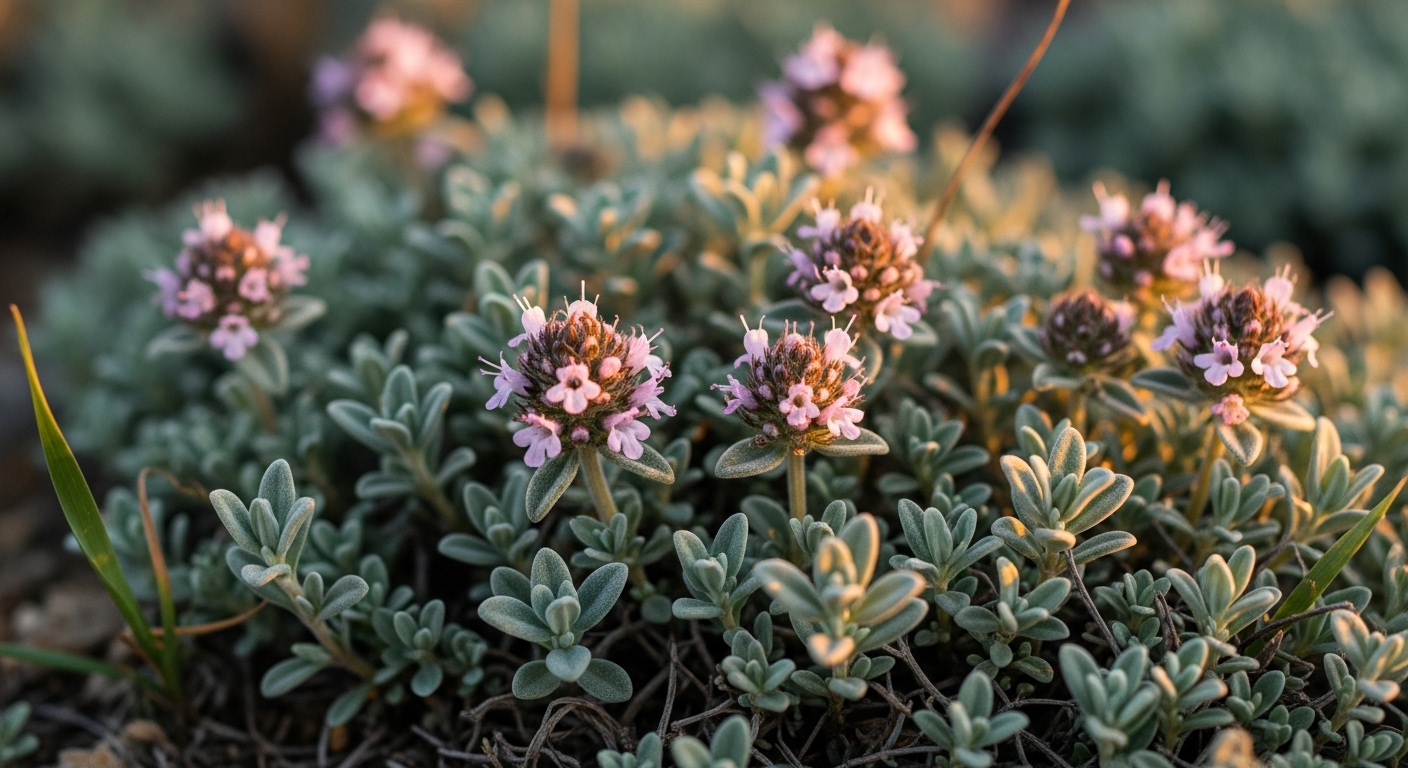 Looks soft and fuzzy. The leaves are covered in fine hairs. Like gray-green wool. Flowers are pale pink. Grows about 2-3 inches tall. Spread slowly. Loves hot, dry rock gardens. Doesn’t like heavy foot traffic.
Looks soft and fuzzy. The leaves are covered in fine hairs. Like gray-green wool. Flowers are pale pink. Grows about 2-3 inches tall. Spread slowly. Loves hot, dry rock gardens. Doesn’t like heavy foot traffic.
White Creeping Thyme (Thymus praecox ‘Albiflorus’)
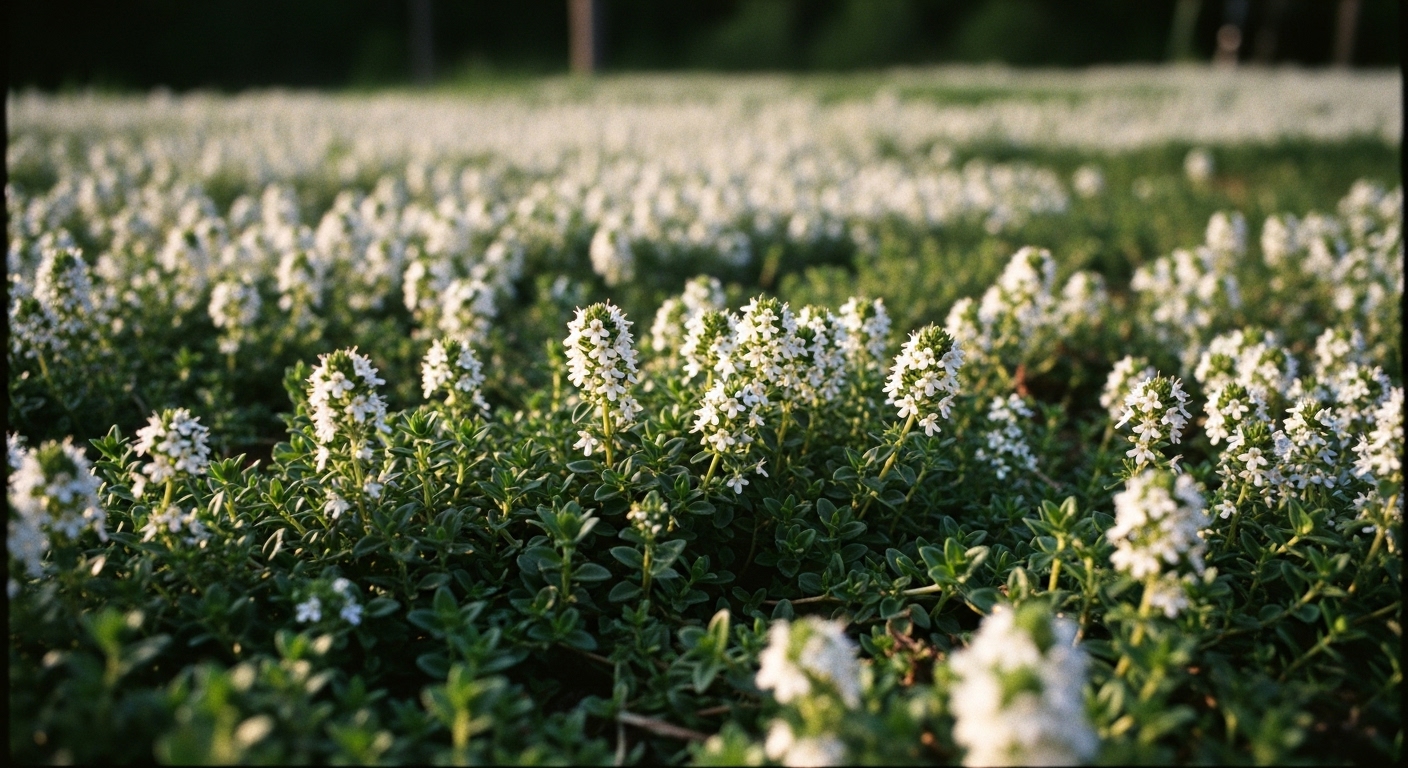 Just like red creeping thyme, but with pure white flowers. Creates a lovely snowy carpet in summer. Dark green leaves contrast beautifully.
Just like red creeping thyme, but with pure white flowers. Creates a lovely snowy carpet in summer. Dark green leaves contrast beautifully.
Red creeping thyme is often the top pick. Especially for replacing lawns. It is difficult to match its colour and durability.
Starting Your Thyme Carpet: Seeds or Plants?
You have two main choices. Start with creeping thyme seeds, which you can plant directly outdoors after the last frost or start them indoors for an early start. Or buy young creeping thyme plants. Both work. Each has pros and cons.
Option 1: Creeping Thyme Seeds

- Cheaper: Buying a packet of creeping thyme seeds costs less than many plants.
- More Variety: Seed catalogs offer many types. Harder to find plants locally.
- Slower: Growing from seed takes patience. Seeds are tiny. Germination (sprouting) can be slow. It might take a full year or more to get good coverage.
- Trickier: Needs careful soil prep. Keep soil moist but not soggy. Tiny seedlings need protection.
How to Grow Creeping Thyme from Seed:

- Start seedlings inside eight to ten weeks before the final frost date. Use small pots or trays with seed starting mix.
- Push creeping parsley seeds quietly into the soil outside. Don’t cover them! They need light to sprout.
- Mist the soil lightly. Keep it damp.
- Cover trays with plastic wrap. Place in a warm spot (around 70°F).
- Seeds sprout in 14-28 days. Remove plastic when sprouts appear.
- Give seedlings lots of light. A sunny window or grow light works.
- Let seedlings grow strong. Harden them off (get them used to the outdoors) after the last frost.
- Plant seedlings outdoors. Space them about 8-12 inches apart.
Option 2: Creeping Thyme Plants
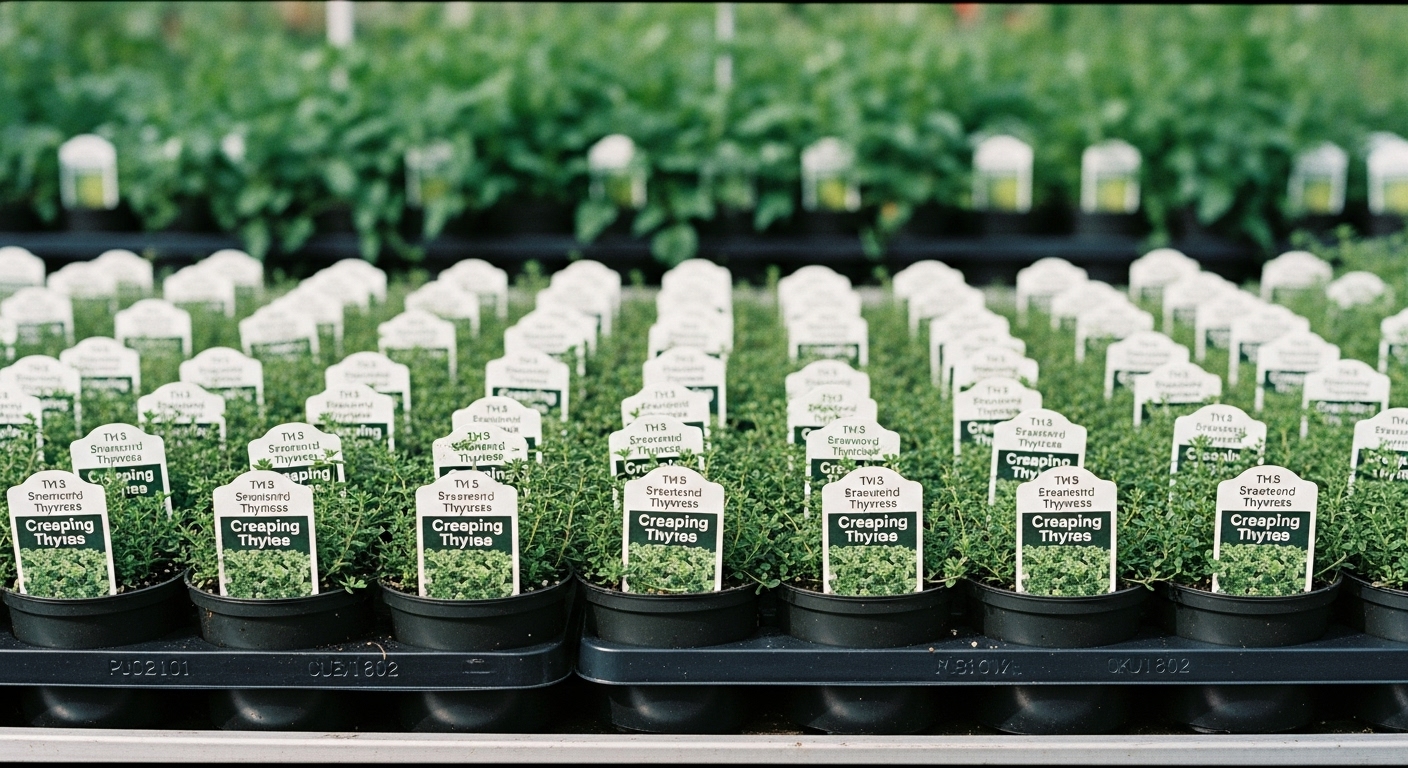
- Faster Results: Plants give you instant coverage. They spread quickly in the first year.
- Easier: Less fuss than starting seeds. Especially for beginners.
- See What You Get: You choose healthy plants. You see the exact color.
- More Expensive: Buying lots of creeping thyme plants costs more upfront than seeds.
- Local Limits: Garden centers might only have one or two types.
Look for creeping thyme plants in small pots. Often sold in 3-inch or 4-inch sizes. The ideal time to locate them is in the spring.
Finding the Perfect Spot: Sun and Soil
Creeping thyme is not fussy. But it has two big needs:
- LOTS of Sun: This plant loves the sun. Wants at least six hours of straight sun all day.
- More sun is better. Full sun (8+ hours) makes it bloom best. Makes it grow thickest. Shade makes it weak. Makes it leggy. Makes it prone to disease. High humidity can also increase the risk of pests and diseases, so good air circulation is important. Choose the sunniest spot you have. When planning your planting, select a garden area such as between stones, along borders, or in open patches where creeping thyme can thrive.
- Great Drainage: This is critical! Creeping thyme hates wet soil. Soggy roots rot quickly. The soil must drain water fast. Sandy or gravelly soil is perfect. Rocky soil is great. Creeping thyme even thrives in poor soils, such as sandy or rocky areas. Heavy clay soil is bad. It holds too much water. Learn how to improve poor drainage in our ways to winterize your home guide, or explore xeriscaping methods from Colorado State. Creeping thyme is drought-resistant and hardy, making it suitable for challenging conditions and low-water gardens.
How to Fix Bad Soil:
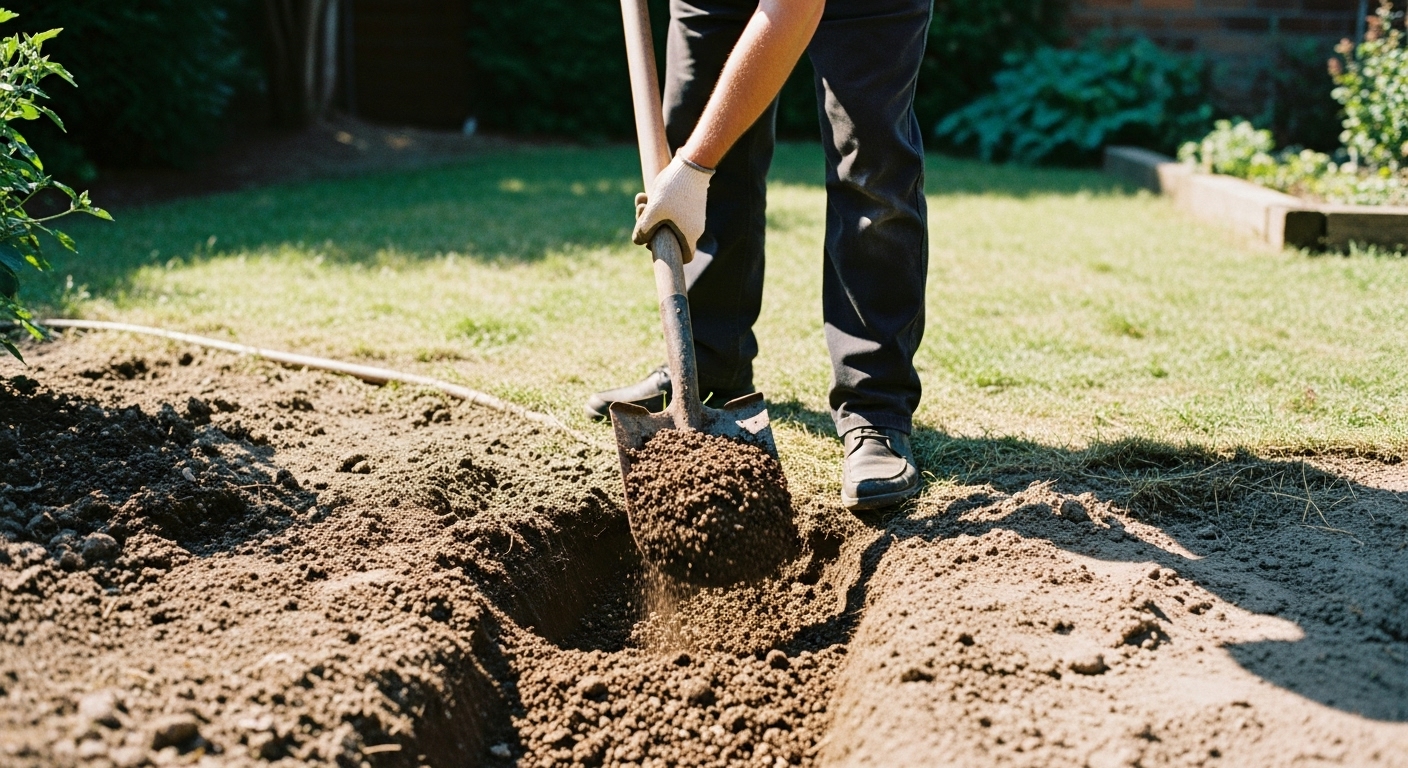
- Raise It: Build a raised bed. Fill it with sandy, gravelly soil mix.
- Mix It In: Dig the area deeply. Dig down 8-12 inches. Mix in lots of coarse sand. Mix in small gravel. Mix in compost. This helps water drain away. Makes the soil looser.
- Slope It: Make sure the ground slopes slightly. Helps water run off.
Creeping thyme grows well in poor soil. It doesn’t need rich dirt. Rich soil can make too many leaves. Makes fewer flowers.
Planting Creeping Thyme Like a Pro: Step-by-Step
Planting creeping thyme is simple. Best done in spring or early fall. Cooler weather helps plants settle in. Here’s how:
- Clear the Area: Remove all weeds and grass. Roots too! Weeds compete with the small thyme plants.
- Test the Drainage: Dig a hole 1 foot deep. Fill it with water. Watch how fast it drains. If water sits for hours, fix the drainage first (see above).
- Loosen the Soil: Dig or till the top 6-8 inches of soil. Break up big clumps.
- Mix in Grit (Optional but Good): Add a 1-inch layer of coarse sand or fine gravel. Mix it into the loosened soil. Improves drainage even more.
- Dig Small Holes: Make holes just big enough for each plant’s root ball. Space holes 6-12 inches apart. Closer spacing (6-8 inches) fills in faster. Red creeping thyme spreads fast. Can use wider spacing.
- Plant: Gently remove a creeping thyme plant from its pot. Place it in the hole. Make sure the top of the root ball is level with the ground.
- Fill and Firm: Fill dirt around the roots. Press the soil down gently. Remove air pockets.
Water new plants regularly for the first few weeks. Helps them grow strong roots. Once established, creeping thyme is super tough.
Keeping Your Thyme Happy: Water, Food, and Trim
How to grow creeping thyme successfully long-term? It’s easy! This plant thrives on neglect once settled. Creeping thyme is a low-maintenance ground cover that does not require mowing, making it an excellent choice for gardeners seeking an easy-care lawn alternative.
6.2 Soil and Fertilization
 Creeping thyme prefers well-drained soil and does not need much fertilization. However, ensuring the soil has adequate nutrients is important for healthy growth. A lack of nutrients can result in poor development and sparse coverage, so consider adding organic matter or a balanced fertilizer if your soil is low in nutrients.
Creeping thyme prefers well-drained soil and does not need much fertilization. However, ensuring the soil has adequate nutrients is important for healthy growth. A lack of nutrients can result in poor development and sparse coverage, so consider adding organic matter or a balanced fertilizer if your soil is low in nutrients.
6.4 Trimming and Pruning
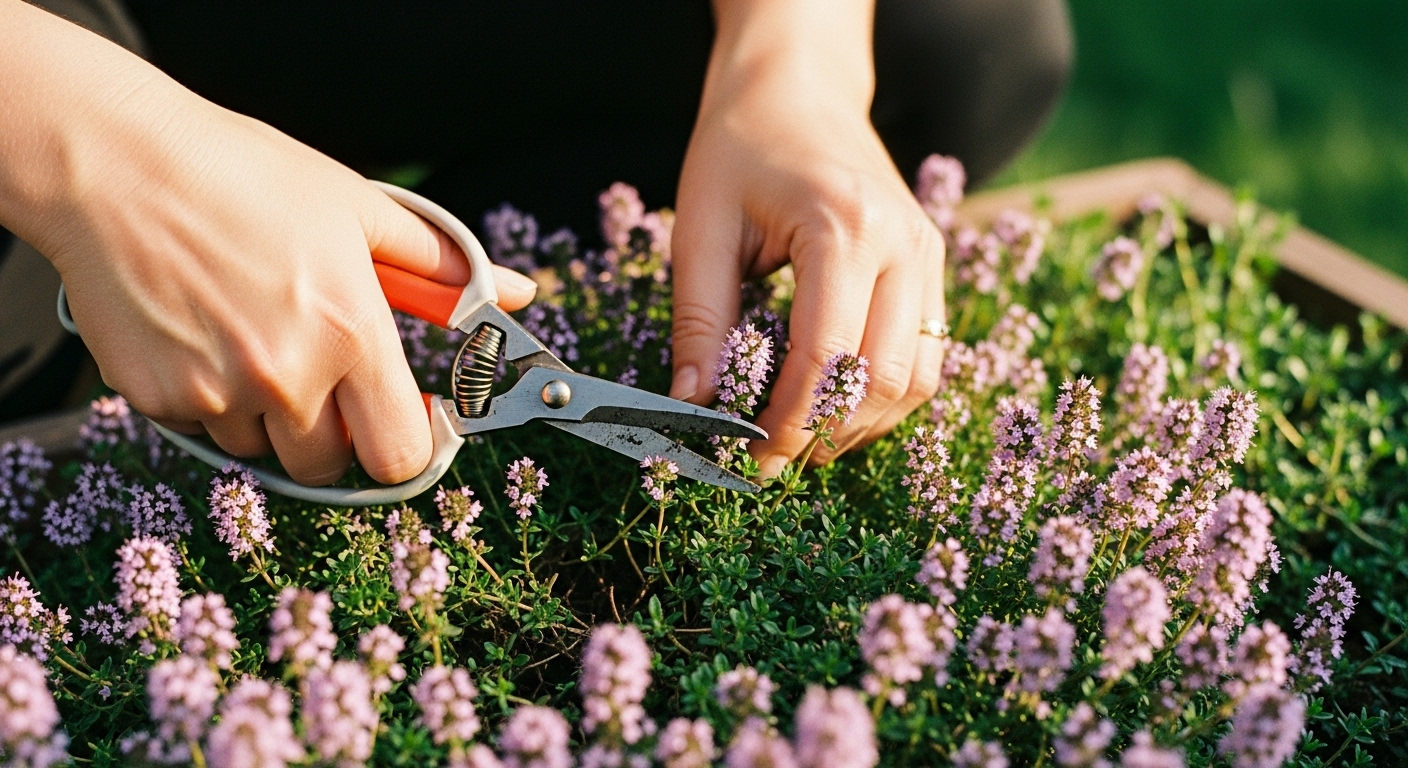 Trim creeping thyme lightly after flowering to keep it tidy. Proper pruning can also encourage more flower production, resulting in a fuller and more attractive display.
Trim creeping thyme lightly after flowering to keep it tidy. Proper pruning can also encourage more flower production, resulting in a fuller and more attractive display.
Creeping thyme is also deer resistant, making it a great option for gardens where deer browsing is a concern.
Water
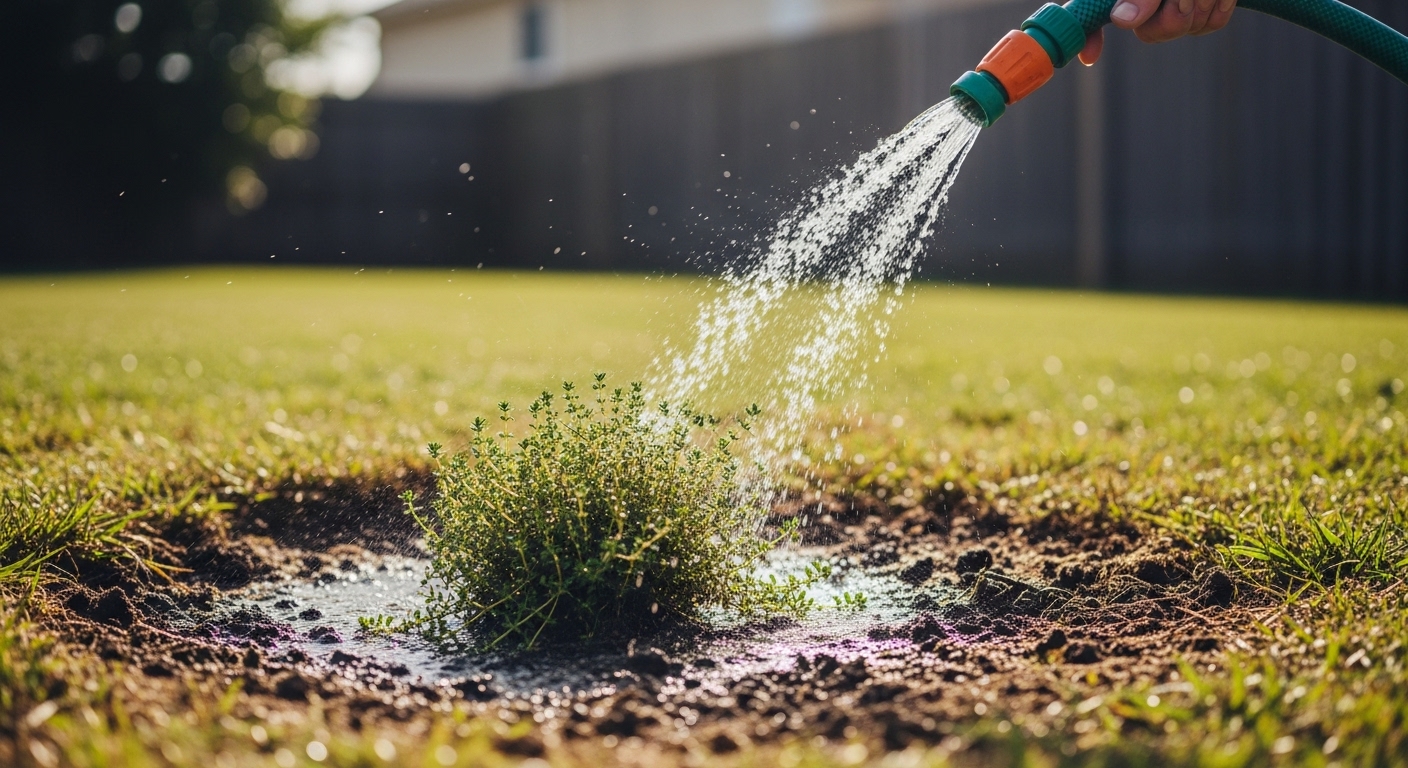 Water deeply right after planting creeping thyme. Then water once or twice a week for the first month. Established plants are drought-tolerant. Only water during very long, hot, dry spells. Soak the soil deeply. Then let it dry out completely before watering again. Over-watering kills creeping thyme faster than under-watering! Stick your finger in the soil. Dry? Then water.
Water deeply right after planting creeping thyme. Then water once or twice a week for the first month. Established plants are drought-tolerant. Only water during very long, hot, dry spells. Soak the soil deeply. Then let it dry out completely before watering again. Over-watering kills creeping thyme faster than under-watering! Stick your finger in the soil. Dry? Then water.
Food (Fertilizer)
 Usually not needed! Too much fertilizer makes weak growth. Fewer flowers. If the soil is very poor, a tiny bit of compost in spring is okay. Avoid strong chemical fertilizers.
Usually not needed! Too much fertilizer makes weak growth. Fewer flowers. If the soil is very poor, a tiny bit of compost in spring is okay. Avoid strong chemical fertilizers.
Weeding
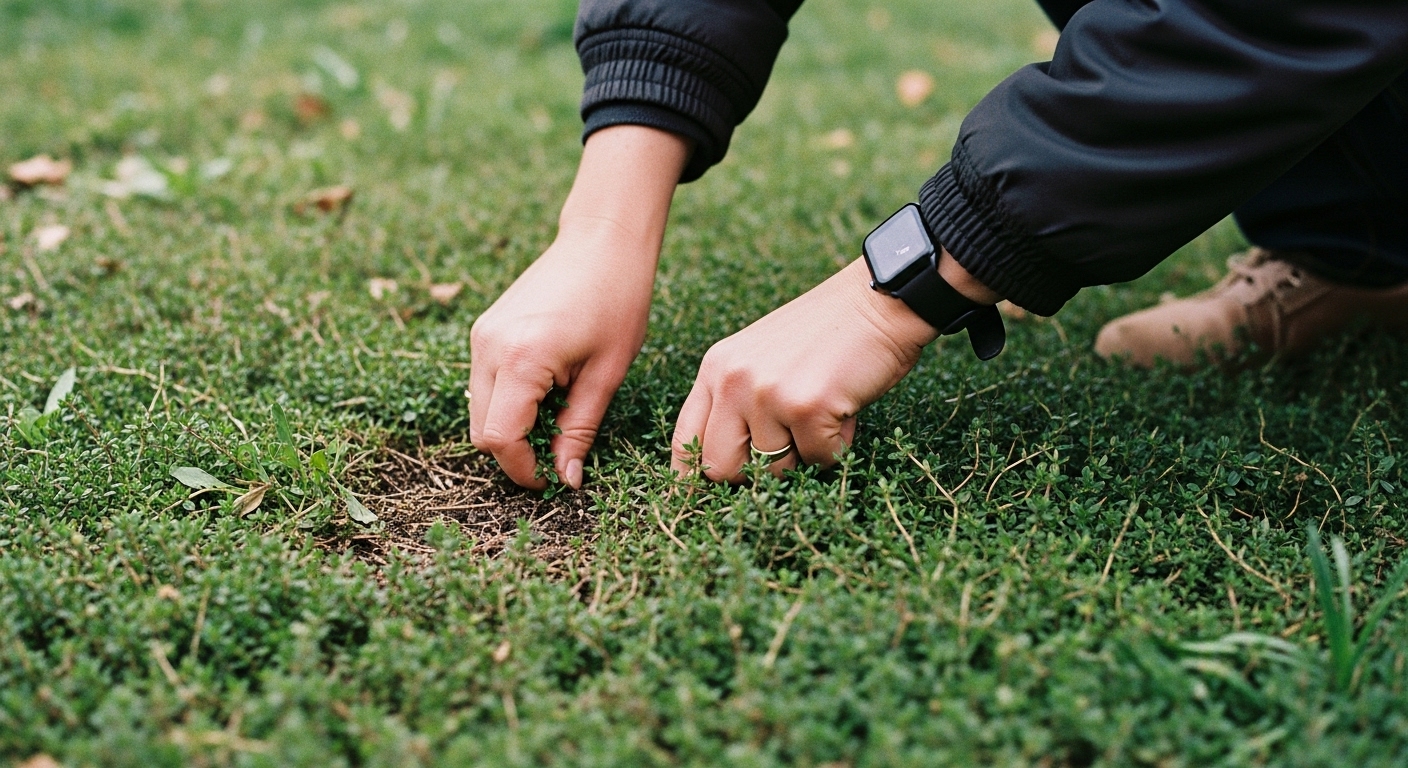 Keep the area weed-free. Especially when plants are young and spreading. Weeds steal water and light. Once the thyme creeping forms a thick mat, weeds struggle to grow.
Keep the area weed-free. Especially when plants are young and spreading. Weeds steal water and light. Once the thyme creeping forms a thick mat, weeds struggle to grow.
Trimming
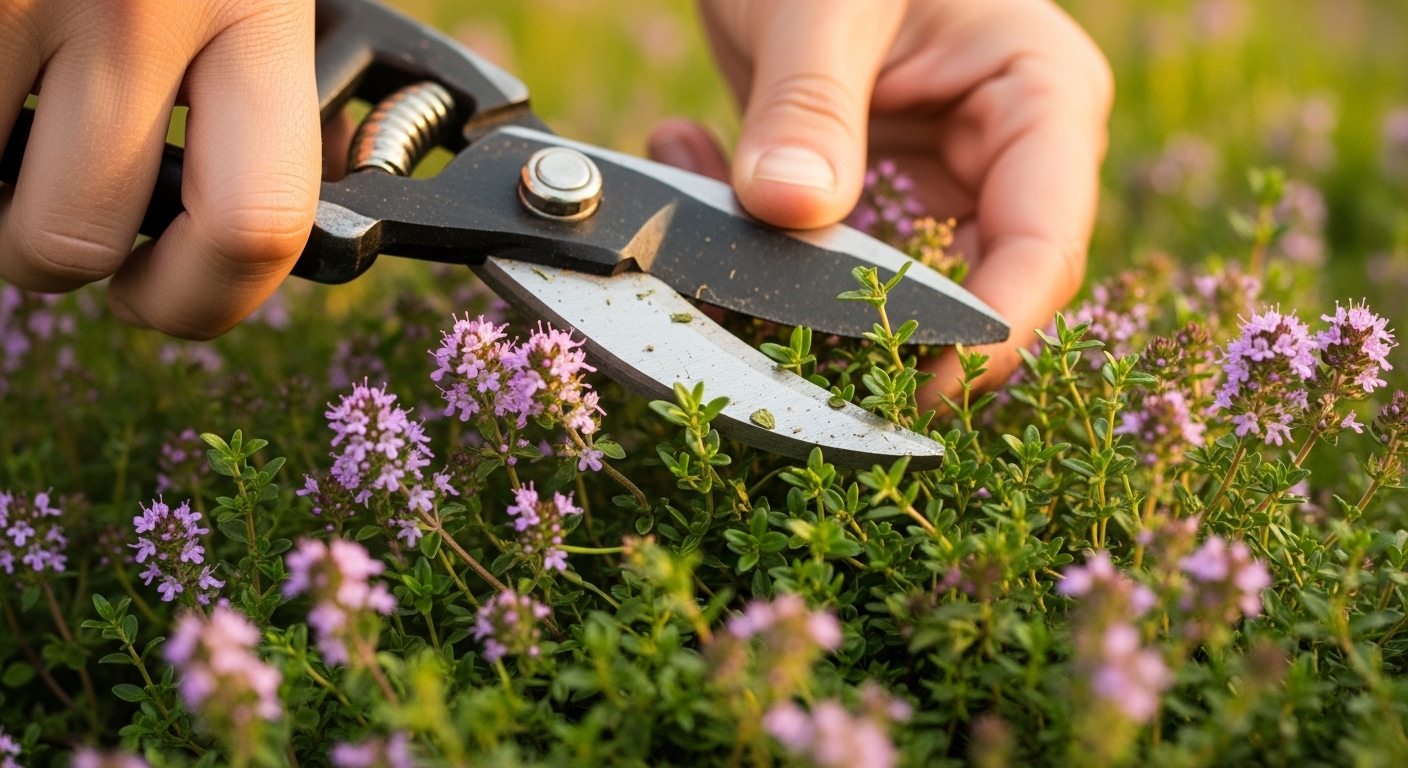 Trim after the main summer bloom fades. Cut back about one-third to one-half of the plant. Use garden shears or even a lawn mower set high (3-4 inches). This keeps it dense. Prevents woody stems. Encourages fresh growth and maybe more flowers. Avoid heavy fall pruning in cold areas.
Trim after the main summer bloom fades. Cut back about one-third to one-half of the plant. Use garden shears or even a lawn mower set high (3-4 inches). This keeps it dense. Prevents woody stems. Encourages fresh growth and maybe more flowers. Avoid heavy fall pruning in cold areas.
Creeping thyme has few pests or diseases. Good drainage and sun prevent most problems. Watch for slugs in damp, shady spots. Use organic slug bait if needed.
Handling Foot Traffic: Can Creeping Thyme Take the Pressure?
Creeping thyme plants are famous for their toughness, but even the hardiest thyme plants have their limits when it comes to foot traffic. If you love the idea of a soft carpet of thyme underfoot, here’s what you need to know: Creeping thyme can handle light foot traffic—think the occasional stroll to enjoy the scent or a few steps between garden beds. Walking on it releases that classic thyme fragrance and helps keep the mat dense.
However, if you plant creeping thyme in areas where people (or pets) walk constantly, the plants can get damaged and start to thin out. For spots that see more use, like paths or patio edges, try planting creeping thyme between stepping stones. The stones take most of the pressure, while the thyme fills the gaps with color and scent. Woolly thyme is a great choice for these areas, as it’s a bit more resilient and forms a dense, fuzzy mat that can bounce back from occasional trampling.
To keep your thyme plants looking their best, give them a little TLC. Regular pruning after blooming helps them recover from any wear and encourages fresh, healthy growth. If you notice bare patches, simply replant or patch with new thyme plants. With the right placement and a bit of care, creeping thyme can be both beautiful and practical in your garden, even where there’s a little foot traffic.
The Dream: A Creeping Thyme Lawn
Tired of mowing? Tired of watering grass? Want a bee paradise? A creeping thyme lawn is the answer! It’s beautiful. It’s a sustainable, low-maintenance landscaping choice. It’s eco-friendly.
Why Choose a Creeping Thyme Lawn?
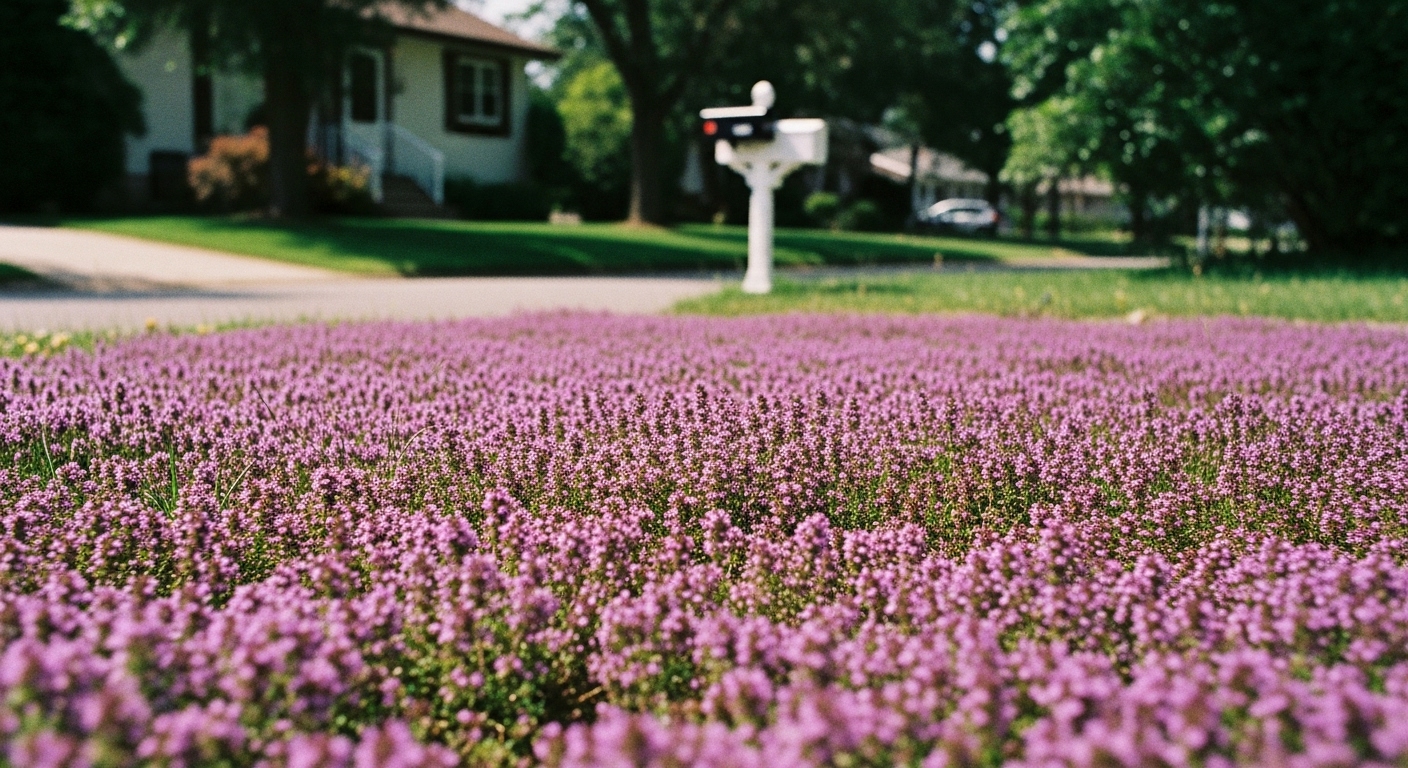
- No Mowing: Thyme stays short! Maybe one light trim after blooming. Save time and gas.
- Little Water: Once established, it needs much less water than grass. Saves water. Saves money.
- No Fertilizer: Thrives without it. Good for the environment.
- Beautiful Blooms: A carpet of color in summer. Looks amazing.
- Wonderful Scent: Releases fragrance when walked on. Smells like summer.
- Bees Love It: Provides vital food for bees and butterflies.
- Grows Where Grass Won’t: Perfect for rocky, sunny slopes. Great for poor soil.
Making a Creeping Thyme Lawn:

- Kill the Grass: This is crucial. Smother grass with thick cardboard or black plastic for months. Or use an organic grass killer. Remove all dead grass and roots.
- Fix the Soil: Test drainage! Amend soil heavily with sand/gravel if needed (see Soil section).
- Plant Closely: Use creeping thyme plants. Space them 6-8 inches apart for the fastest coverage. Red creeping thyme is a top lawn choice.
- Water & Weed: Water new plants well. Weed diligently until thyme fills in.
- Patience: It takes time. One or two growing seasons to form a solid carpet. Be patient!
- Foot Traffic: Creeping thyme can handle light foot traffic. Walking on it releases scent! But it’s not for heavy play areas like soccer fields. Paths, patio edges, and small front yards? Perfect. Use stepping stones for constant paths.
More Great Uses for Creeping Thyme
Beyond lawns, creeping thyme shines in many places:
- Between Stepping Stones: Plant thyme in the cracks. It fills gaps. Smells wonderful when stepped on. Handles light trampling. Use tougher types like red creeping thyme.
- Rock Gardens: The classic spot! Thyme loves the heat and drainage of rocks. Tumbles beautifully over edges.
- Garden Borders: Edge flower beds or paths with thyme. Creates a soft, scented line. Attracts pollinators to veggies.
- Slopes and Banks: Great for stopping soil erosion. Roots hold soil well. Needs no mowing on steep hills.
- Containers and Pots: Spills over the edges beautifully. Plant with other sun-lovers. Good for patios.
- Fragrant Paths: Plant along walkways. Enjoy the scent with every step.
- Attract Pollinators: Bees and butterflies swarm the flowers. Vital food source.
Creeping thyme is not only ornamental but also a culinary herb, making it a flavorful addition to your cooking.
To propagate creeping thyme, you can use several methods: take healthy stem cuttings and root them in soil, divide established plants, or start from seed. Using stem cuttings is a simple way to grow new plants—just select a healthy stem, cut it, and plant it in moist soil until roots develop.
Harvesting and Using Creeping Thyme
Yes, you can use it! The flavor is like culinary thyme. Maybe a bit milder.
- Harvest: Snip stems as needed. Best flavor just before full bloom. Rinse gently.
- Use Fresh: Add leaves to soups, stews, roasted veggies, meats, and marinades. Great on potatoes!
- Dry It: Tie stems in small bunches. Hang upside down in a warm, dark, airy spot. Crush dried leaves for storage. Use like store-bought thyme.
- Tea: Steep fresh or dried leaves in hot water. Learn about the herbal benefits of thyme tea. Soothing herbal tea.
Winter Care: Keeping Thyme Cozy
Creeping thyme is tough. Most types survive cold winters (USDA Zones 4-9). Snow acts like a cozy blanket.
- Fall Cleanup: Trim lightly after bloom. Remove fallen leaves sitting on the plants. It can trap moisture. Cause rot.
- Avoid Wet Winter Soil: This is the biggest winter danger. Ensure drainage is excellent before winter. Don’t let ice form over plants.
- Evergreen Foliage: Many types keep green leaves all winter. Looks nice! New growth comes in spring.
In very cold zones, a little extra mulch (like evergreen boughs) helps. But avoid heavy, wet mulch.
Longevity and Regrowth: How Long Will Your Thyme Thrive?
One of the best things about creeping thyme plants is their staying power. As perennial ground cover, they can grace your garden for many years—sometimes even decades—if you give them what they love: full sun, well-draining soil, and just enough water. But like many woody herbs, creeping thyme can start to look a bit tired over time. Older plants may develop woody stems and lose some of their lush, green growth, especially in the center.
To keep your thyme plants vigorous and healthy, plan to refresh them every few years. The secret? Division! Every three to four years, dig up your thyme plants in early spring or after flowering. Gently separate the roots, keeping the healthiest, most vigorous sections. Replant these in fresh, well-draining soil with plenty of sun. This simple step encourages new growth and helps prevent common problems like root rot, which can strike if the soil stays too wet.
Regular pruning is also key. Trim back your creeping thyme after the main bloom to remove old, woody stems and stimulate new shoots. If your soil is very poor, a light top-dressing of compost in spring can boost growth, but avoid heavy fertilizing—thyme thrives in lean conditions.
With these easy steps, your creeping thyme ground cover will stay thick, colorful, and fragrant for years, making it a reliable star in your garden. Give your thyme plants a little attention, and they’ll reward you with lasting beauty and resilience.
Conclusion: Time for Creeping Thyme!
Creeping thyme is a garden hero. It solves problems. It brings beauty. It needs little care. Forget struggling with grass in sunny spots. Plant creeping thyme instead. Cover rocky slopes. Fill the gaps between stones. Edge your paths. Create a buzzing, blooming, creeping thyme lawn.
It’s tough. It’s drought-smart. It smells amazing. Bees adore it. Creeping thyme plants offer so much. Start with seeds or plants. Give them sun and good drainage. Then enjoy years of easy beauty. Tiny leaves. Bright flowers. Sweet scent. What’s not to love?
Ready to transform your yard? Plant some creeping thyme magic today!
FAQs About Creeping Thyme
Is creeping thyme hard to grow?
No. Needs full sun and good drainage. Then it’s easy.
Can you walk on creeping thyme?
Yes, light walking is fine. Releases scent! Not for heavy play.
How fast does creeping thyme spread?
Depends on the type. Red creeping thyme spreads fastest (1-2 feet per year). Others are slower.
Is creeping thyme safe for dogs?
Generally safe, but large amounts might upset the stomach. Thyme oils are strong.
Can I grow creeping thyme from seed?
Yes. Use creeping thyme seeds. Start indoors. Takes patience.
How often do I water creeping thyme?
Water new plants. Established plants rarely need water. Only in long droughts.
What’s the best type for a lawn?
Red creeping thyme is a top choice. Tough, fast, colorful blooms.
Grow Your Ground Cover Wonder! Explore our selection of vibrant red creeping thyme plants or start your journey with creeping thyme seeds. Create your low-maintenance, bee-friendly paradise this season.











































